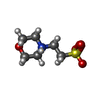+Search query
-Structure paper
| Title | Identification of a cross-neutralizing antibody that targets the receptor binding site of H1N1 and H5N1 influenza viruses. |
|---|---|
| Journal, issue, pages | Nat Commun, Vol. 13, Issue 1, Page 5182, Year 2022 |
| Publish date | Sep 2, 2022 |
 Authors Authors | Tingting Li / Junyu Chen / Qingbing Zheng / Wenhui Xue / Limin Zhang / Rui Rong / Sibo Zhang / Qian Wang / Minqing Hong / Yuyun Zhang / Lingyan Cui / Maozhou He / Zhen Lu / Zhenyong Zhang / Xin Chi / Jinjin Li / Yang Huang / Hong Wang / Jixian Tang / Dong Ying / Lizhi Zhou / Yingbin Wang / Hai Yu / Jun Zhang / Ying Gu / Yixin Chen / Shaowei Li / Ningshao Xia /  |
| PubMed Abstract | Influenza A viruses pose a significant threat globally each year, underscoring the need for a vaccine- or antiviral-based broad-protection strategy. Here, we describe a chimeric monoclonal antibody, ...Influenza A viruses pose a significant threat globally each year, underscoring the need for a vaccine- or antiviral-based broad-protection strategy. Here, we describe a chimeric monoclonal antibody, C12H5, that offers neutralization against seasonal and pandemic H1N1 viruses, and cross-protection against some H5N1 viruses. Notably, C12H5 mAb offers broad neutralizing activity against H1N1 and H5N1 viruses by controlling virus entry and egress, and offers protection against H1N1 and H5N1 viral challenge in vivo. Through structural analyses, we show that C12H5 engages hemagglutinin (HA), the major surface glycoprotein on influenza, at a distinct epitope overlapping the receptor binding site and covering the 140-loop. We identified eight highly conserved (~90%) residues that are essential for broad H1N1 recognition, with evidence of tolerance for Asp or Glu at position 190; this site is a molecular determinant for human or avian host-specific recognition and this tolerance endows C12H5 with cross-neutralization potential. Our results could benefit the development of antiviral drugs and the design of broad-protection influenza vaccines. |
 External links External links |  Nat Commun / Nat Commun /  PubMed:36056024 / PubMed:36056024 /  PubMed Central PubMed Central |
| Methods | EM (single particle) / X-ray diffraction |
| Resolution | 3.14 - 3.151 Å |
| Structure data | EMDB-33831, PDB-7yhk:  PDB-7fah: |
| Chemicals |  ChemComp-NAG:  ChemComp-MES: |
| Source |
|
 Keywords Keywords | VIRAL PROTEIN/IMMUNE SYSTEM / Influenza virus / HA / Receptor binding site / neutralizing antibody / VIRAL PROTEIN / VIRAL PROTEIN-IMMUNE SYSTEM complex / Hemagglutinin |
 Movie
Movie Controller
Controller Structure viewers
Structure viewers About Yorodumi Papers
About Yorodumi Papers





 influenza a virus (a/beijing/262/1995(h1n1))
influenza a virus (a/beijing/262/1995(h1n1))
